[English] 日本語
 Yorodumi
Yorodumi- PDB-3c34: Crystal structure of GluR5 ligand-binding core in complex with ru... -
+ Open data
Open data
- Basic information
Basic information
| Entry | Database: PDB / ID: 3c34 | ||||||
|---|---|---|---|---|---|---|---|
| Title | Crystal structure of GluR5 ligand-binding core in complex with rubidium at 1.82 Angstrom resolution | ||||||
 Components Components | GLUTAMATE RECEPTOR, IONOTROPIC KAINATE 1 | ||||||
 Keywords Keywords |  MEMBRANE PROTEIN MEMBRANE PROTEIN | ||||||
| Function / homology |  Function and homology information Function and homology informationgamma-aminobutyric acid secretion / negative regulation of synaptic transmission, GABAergic / L-glutamate transmembrane transporter activity / positive regulation of gamma-aminobutyric acid secretion / Activation of Na-permeable kainate receptors / kainate selective glutamate receptor complex / Activation of Ca-permeable Kainate Receptor / negative regulation of synaptic transmission, glutamatergic / regulation of short-term neuronal synaptic plasticity /  inhibitory postsynaptic potential ...gamma-aminobutyric acid secretion / negative regulation of synaptic transmission, GABAergic / L-glutamate transmembrane transporter activity / positive regulation of gamma-aminobutyric acid secretion / Activation of Na-permeable kainate receptors / kainate selective glutamate receptor complex / Activation of Ca-permeable Kainate Receptor / negative regulation of synaptic transmission, glutamatergic / regulation of short-term neuronal synaptic plasticity / inhibitory postsynaptic potential ...gamma-aminobutyric acid secretion / negative regulation of synaptic transmission, GABAergic / L-glutamate transmembrane transporter activity / positive regulation of gamma-aminobutyric acid secretion / Activation of Na-permeable kainate receptors / kainate selective glutamate receptor complex / Activation of Ca-permeable Kainate Receptor / negative regulation of synaptic transmission, glutamatergic / regulation of short-term neuronal synaptic plasticity /  inhibitory postsynaptic potential / inhibitory postsynaptic potential /  synaptic transmission, GABAergic / synaptic transmission, GABAergic /  glutamate binding / glutamate binding /  adult behavior / modulation of excitatory postsynaptic potential / behavioral response to pain / adult behavior / modulation of excitatory postsynaptic potential / behavioral response to pain /  membrane depolarization / kainate selective glutamate receptor activity / membrane depolarization / kainate selective glutamate receptor activity /  ionotropic glutamate receptor complex / extracellularly glutamate-gated ion channel activity / glutamate-gated receptor activity / ligand-gated monoatomic ion channel activity involved in regulation of presynaptic membrane potential / ionotropic glutamate receptor complex / extracellularly glutamate-gated ion channel activity / glutamate-gated receptor activity / ligand-gated monoatomic ion channel activity involved in regulation of presynaptic membrane potential /  excitatory postsynaptic potential / presynaptic modulation of chemical synaptic transmission / ionotropic glutamate receptor signaling pathway / excitatory postsynaptic potential / presynaptic modulation of chemical synaptic transmission / ionotropic glutamate receptor signaling pathway /  regulation of membrane potential / regulation of membrane potential /  SNARE binding / transmitter-gated monoatomic ion channel activity involved in regulation of postsynaptic membrane potential / SNARE binding / transmitter-gated monoatomic ion channel activity involved in regulation of postsynaptic membrane potential /  synaptic transmission, glutamatergic / establishment of localization in cell / positive regulation of synaptic transmission, GABAergic / postsynaptic density membrane / synaptic transmission, glutamatergic / establishment of localization in cell / positive regulation of synaptic transmission, GABAergic / postsynaptic density membrane /  regulation of synaptic plasticity / modulation of chemical synaptic transmission / regulation of synaptic plasticity / modulation of chemical synaptic transmission /  terminal bouton / terminal bouton /  presynaptic membrane / presynaptic membrane /  nervous system development / chemical synaptic transmission / nervous system development / chemical synaptic transmission /  scaffold protein binding / scaffold protein binding /  postsynaptic density / postsynaptic density /  receptor complex / receptor complex /  dendrite / neuronal cell body / glutamatergic synapse / dendrite / neuronal cell body / glutamatergic synapse /  synapse / synapse /  membrane / identical protein binding / membrane / identical protein binding /  plasma membrane plasma membraneSimilarity search - Function | ||||||
| Biological species |   Rattus norvegicus (Norway rat) Rattus norvegicus (Norway rat) | ||||||
| Method |  X-RAY DIFFRACTION / X-RAY DIFFRACTION /  SYNCHROTRON / SYNCHROTRON /  FOURIER SYNTHESIS / Resolution: 1.82 Å FOURIER SYNTHESIS / Resolution: 1.82 Å | ||||||
 Authors Authors | Mayer, M.L. | ||||||
 Citation Citation |  Journal: Neuron / Year: 2008 Journal: Neuron / Year: 2008Title: Molecular basis of kainate receptor modulation by sodium. Authors: Plested, A.J. / Vijayan, R. / Biggin, P.C. / Mayer, M.L. #1:  Journal: Neuron / Year: 2007 Journal: Neuron / Year: 2007Title: Structure and mechanism of kainate receptor modulation by anions. Authors: Plested, A.J. / Mayer, M.L. #2:  Journal: Neuron / Year: 2005 Journal: Neuron / Year: 2005Title: Crystal structures of the GluR5 and GluR6 ligand binding cores: molecular mechanisms underlying kainate receptor selectivity. Authors: Mayer, M.L. | ||||||
| History |
|
- Structure visualization
Structure visualization
| Structure viewer | Molecule:  Molmil Molmil Jmol/JSmol Jmol/JSmol |
|---|
- Downloads & links
Downloads & links
- Download
Download
| PDBx/mmCIF format |  3c34.cif.gz 3c34.cif.gz | 132.4 KB | Display |  PDBx/mmCIF format PDBx/mmCIF format |
|---|---|---|---|---|
| PDB format |  pdb3c34.ent.gz pdb3c34.ent.gz | 102.5 KB | Display |  PDB format PDB format |
| PDBx/mmJSON format |  3c34.json.gz 3c34.json.gz | Tree view |  PDBx/mmJSON format PDBx/mmJSON format | |
| Others |  Other downloads Other downloads |
-Validation report
| Arichive directory |  https://data.pdbj.org/pub/pdb/validation_reports/c3/3c34 https://data.pdbj.org/pub/pdb/validation_reports/c3/3c34 ftp://data.pdbj.org/pub/pdb/validation_reports/c3/3c34 ftp://data.pdbj.org/pub/pdb/validation_reports/c3/3c34 | HTTPS FTP |
|---|
-Related structure data
| Related structure data |  3c31SC  3c32C  3c33C  3c35C 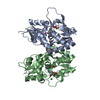 3c36C S: Starting model for refinement C: citing same article ( |
|---|---|
| Similar structure data |
- Links
Links
- Assembly
Assembly
| Deposited unit | 
| ||||||||
|---|---|---|---|---|---|---|---|---|---|
| 1 |
| ||||||||
| Unit cell |
|
- Components
Components
-Protein , 1 types, 2 molecules AB
| #1: Protein |  / Glutamate receptor 5 / GluR-5 / GluR5 / Glutamate receptor 5 / GluR-5 / GluR5Mass: 29253.566 Da / Num. of mol.: 2 / Fragment: Residues 446-821 Source method: isolated from a genetically manipulated source Details: REMARK 999 THE FIRST TWO RESIDUES OF THE SEQUENCE ARE REMARK 999 VECTOR ENCODED . GLUR5 RESIDUES 446-559 AND REMARK 999 682-821 ARE LINKED VIA GLY-THR DIPEPTIDE . Source: (gene. exp.)   Rattus norvegicus (Norway rat) / Gene: GRIK1, GLUR5 / Plasmid: Modified pET22b / Production host: Rattus norvegicus (Norway rat) / Gene: GRIK1, GLUR5 / Plasmid: Modified pET22b / Production host:   Escherichia coli (E. coli) / Strain (production host): ORIGAMI B(DE3) / References: UniProt: P22756 Escherichia coli (E. coli) / Strain (production host): ORIGAMI B(DE3) / References: UniProt: P22756 |
|---|
-Non-polymers , 5 types, 572 molecules 








| #2: Chemical | ChemComp-RB /  Rubidium Rubidium#3: Chemical | ChemComp-CL /  Chloride Chloride#4: Chemical |  Kainic acid Kainic acid#5: Chemical |  Glycerol Glycerol#6: Water | ChemComp-HOH / |  Water Water |
|---|
-Details
| Sequence details | THE FIRST TWO RESIDUES OF THE SEQUENCE ARE VECTOR ENCODED. GLUR5 RESIDUES 446-559 AND 682-821 ARE ...THE FIRST TWO RESIDUES OF THE SEQUENCE ARE VECTOR ENCODED. GLUR5 RESIDUES 446-559 AND 682-821 ARE LINKED VIA GLY-THR DIPEPTIDE. |
|---|
-Experimental details
-Experiment
| Experiment | Method:  X-RAY DIFFRACTION / Number of used crystals: 1 X-RAY DIFFRACTION / Number of used crystals: 1 |
|---|
- Sample preparation
Sample preparation
| Crystal | Density Matthews: 2.52 Å3/Da / Density % sol: 51.2 % |
|---|---|
Crystal grow | Temperature: 293 K / Method: vapor diffusion, hanging drop / pH: 6 Details: 20% PEG 4000, 125 mM RbCl, 175 mM Rb2(SO4), 100 mM Rb cacodylate, 4 mM Kainic acid, pH 6.0, VAPOR DIFFUSION, HANGING DROP, temperature 293K |
-Data collection
| Diffraction | Mean temperature: 100 K |
|---|---|
| Diffraction source | Source:  SYNCHROTRON / Site: SYNCHROTRON / Site:  APS APS  / Beamline: 22-ID / Wavelength: 1 Å / Beamline: 22-ID / Wavelength: 1 Å |
| Detector | Type: MARMOSAIC 300 mm CCD / Detector: CCD / Date: Nov 14, 2007 |
| Radiation | Monochromator: DOUBLE CRYSTAL SI-220 / Protocol: SINGLE WAVELENGTH / Monochromatic (M) / Laue (L): M / Scattering type: x-ray |
| Radiation wavelength | Wavelength : 1 Å / Relative weight: 1 : 1 Å / Relative weight: 1 |
| Reflection | Resolution: 1.82→40 Å / Num. all: 54555 / Num. obs: 54555 / % possible obs: 99.5 % / Observed criterion σ(F): 0 / Observed criterion σ(I): 0 / Redundancy: 6.3 % / Biso Wilson estimate: 19.6 Å2 / Rmerge(I) obs: 0.075 / Net I/σ(I): 13.9 |
| Reflection shell | Resolution: 1.82→1.89 Å / Redundancy: 6 % / Rmerge(I) obs: 0.423 / Mean I/σ(I) obs: 5.22 / % possible all: 100 |
- Processing
Processing
| Software |
| |||||||||||||||||||||||||||||||||||||||||||||||||||||||||||||||||||||||||||||||||||||||||||||||||||||||||||||||||||||||||||||||||||||||||||||||||||||||||||||||||||||||||||||||||||||||||||||||||||||||||||||||||||||||||||||||||
|---|---|---|---|---|---|---|---|---|---|---|---|---|---|---|---|---|---|---|---|---|---|---|---|---|---|---|---|---|---|---|---|---|---|---|---|---|---|---|---|---|---|---|---|---|---|---|---|---|---|---|---|---|---|---|---|---|---|---|---|---|---|---|---|---|---|---|---|---|---|---|---|---|---|---|---|---|---|---|---|---|---|---|---|---|---|---|---|---|---|---|---|---|---|---|---|---|---|---|---|---|---|---|---|---|---|---|---|---|---|---|---|---|---|---|---|---|---|---|---|---|---|---|---|---|---|---|---|---|---|---|---|---|---|---|---|---|---|---|---|---|---|---|---|---|---|---|---|---|---|---|---|---|---|---|---|---|---|---|---|---|---|---|---|---|---|---|---|---|---|---|---|---|---|---|---|---|---|---|---|---|---|---|---|---|---|---|---|---|---|---|---|---|---|---|---|---|---|---|---|---|---|---|---|---|---|---|---|---|---|---|---|---|---|---|---|---|---|---|---|---|---|---|---|---|---|---|
| Refinement | Method to determine structure : :  FOURIER SYNTHESIS FOURIER SYNTHESISStarting model: PDB entry 3C31 Resolution: 1.82→38.1 Å / Cor.coef. Fo:Fc: 0.961 / Cor.coef. Fo:Fc free: 0.939 / SU B: 4.162 / SU ML: 0.071 / TLS residual ADP flag: LIKELY RESIDUAL / Cross valid method: THROUGHOUT / σ(F): 0 / σ(I): 0 / ESU R: 0.119 / ESU R Free: 0.119 / Stereochemistry target values: MAXIMUM LIKELIHOOD / Details: HYDROGENS HAVE BEEN ADDED IN THE RIDING POSITIONS
| |||||||||||||||||||||||||||||||||||||||||||||||||||||||||||||||||||||||||||||||||||||||||||||||||||||||||||||||||||||||||||||||||||||||||||||||||||||||||||||||||||||||||||||||||||||||||||||||||||||||||||||||||||||||||||||||||
| Solvent computation | Ion probe radii: 0.8 Å / Shrinkage radii: 0.8 Å / VDW probe radii: 1.2 Å / Solvent model: BABINET MODEL WITH MASK | |||||||||||||||||||||||||||||||||||||||||||||||||||||||||||||||||||||||||||||||||||||||||||||||||||||||||||||||||||||||||||||||||||||||||||||||||||||||||||||||||||||||||||||||||||||||||||||||||||||||||||||||||||||||||||||||||
| Displacement parameters | Biso mean: 17.32 Å2
| |||||||||||||||||||||||||||||||||||||||||||||||||||||||||||||||||||||||||||||||||||||||||||||||||||||||||||||||||||||||||||||||||||||||||||||||||||||||||||||||||||||||||||||||||||||||||||||||||||||||||||||||||||||||||||||||||
| Refinement step | Cycle: LAST / Resolution: 1.82→38.1 Å
| |||||||||||||||||||||||||||||||||||||||||||||||||||||||||||||||||||||||||||||||||||||||||||||||||||||||||||||||||||||||||||||||||||||||||||||||||||||||||||||||||||||||||||||||||||||||||||||||||||||||||||||||||||||||||||||||||
| Refine LS restraints |
| |||||||||||||||||||||||||||||||||||||||||||||||||||||||||||||||||||||||||||||||||||||||||||||||||||||||||||||||||||||||||||||||||||||||||||||||||||||||||||||||||||||||||||||||||||||||||||||||||||||||||||||||||||||||||||||||||
| LS refinement shell | Resolution: 1.82→1.87 Å / Total num. of bins used: 20
| |||||||||||||||||||||||||||||||||||||||||||||||||||||||||||||||||||||||||||||||||||||||||||||||||||||||||||||||||||||||||||||||||||||||||||||||||||||||||||||||||||||||||||||||||||||||||||||||||||||||||||||||||||||||||||||||||
| Refinement TLS params. | Method: refined / Refine-ID: X-RAY DIFFRACTION
| |||||||||||||||||||||||||||||||||||||||||||||||||||||||||||||||||||||||||||||||||||||||||||||||||||||||||||||||||||||||||||||||||||||||||||||||||||||||||||||||||||||||||||||||||||||||||||||||||||||||||||||||||||||||||||||||||
| Refinement TLS group |
|
 Movie
Movie Controller
Controller







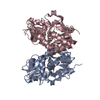
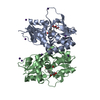
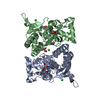
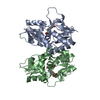

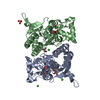
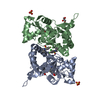
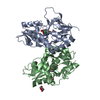

 PDBj
PDBj






